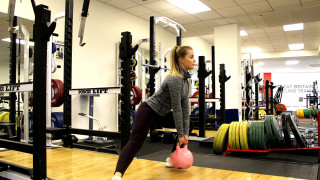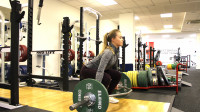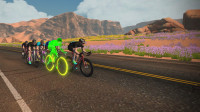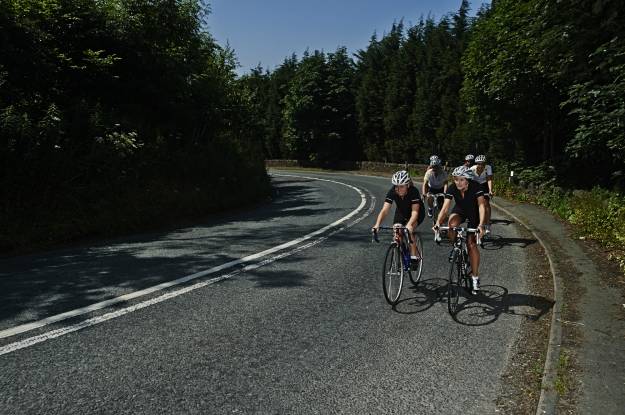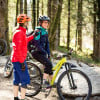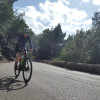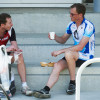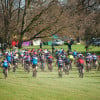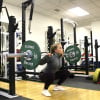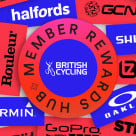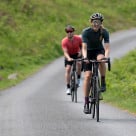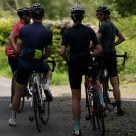Knowledge Level: Intermediate
An option for cross training are group exercise classes. Here we give you the low-down on what to expect from a range of classes and how much benefit they will be for your cycling.
Indoor trainers such as turbos and rollers are a great option and, with training platforms such as Zwift and modern smart trainers, are a world away from the bad old days of staring at a garage wall while be deafened.
However it's beneficial for all cyclists to include some cross-training in their schedule for performance, health and injury prevention benefits. All of our digital traning plans give you to opportunity to include some cross training.
The winter is a great time to work on your off the bike fitness as the short term negative impact on your cycling form doesn't matter so much. Also the warmth, dry and social side of a gym or health club certainly has an appeal during the winter months and, especially if you already have a membership, it makes sense to use it. Our 12-week "Real Life" Winter Training Plan reflects this and has two cross-traning sessions each week.
Spinning
Spinning is a group cycling class on fixed gear (you can’t stop pedaling) bikes with heavy flywheels. Resistance is self-regulated but cues for raising or lowering it are given by the instructor. On most Spinning bikes the resistance adjustment mechanism is fairly basic and doesn’t allow you to quantify the load. Cadence is governed by the beat of the music but the instructor may also ask you to double or half the tempo.
Unless you’re lucky enough to attend a gym with a fleet of Wattbikes or similar, speed, distance and power feedback is typically nonexistent making objectively monitoring progress almost impossible but you can take your heart rate monitor with you to keep an eye on intensity.
It’s usually possible to get a reasonable approximation of your riding position on the road and many Spinning bikes have clipless pedals. How relevant the class is to your training will largely depend on the instructor. Try to find classes where the instructor is a cyclist and remember to take water and a towel, you will sweat!
Yoga
Yoga is an umbrella title for a range of forms, styles and approaches. It includes the extremely athletic and physically demanding Ashtanga or Power Yoga, Iyengar Yoga with its props, straps and cushions and even Bikram Yoga that takes place in specially heated rooms.
Some classes stick to the physical side of practice whereas other more spiritual ones might have you relaxing, meditating or even chanting.
Many instructors fuse the different styles so, knowing which class to chose, can be confusing. If you’re going to a class at your gym or health club, talk to the manager or the instructors, explain that you’ll be practicing yoga as a complimentary activity to cycling and they might be able to point you in the direction of a suitable class.
Often yoga classes work in blocks so that everyone is starting at the same level and works through learning the positions and sequences together.
Try to find a fairly small class of ten to fifteen people as individual attention from the instructor is vital. You’ll think you’ve got a position right and then the instructor will make a microscopic adjustment to you and it’ll feel a whole lot different and usually a lot more painful.
Pilates
Pilates is a training system that was developed in the early 20th century by Joseph Pilates. He developed it primarily as a training and rehabilitation method for dancers and that link to dance and dancers remains today. It emphasises mindful control of the body to build strength, endurance and flexibility of the so-called “core muscles”.
Jospeh Pilates referred to the core as the “powerhouse” of the body and, although it’s not the panacea of fitness that many Pilates enthusiasts and core training evangelists claim it to be, some riders could benefit from working on it. As part of the mindful body control approach Pilates, like yoga, places an emphasis on breathing techniques and relaxation.
The most common, accessible and affordable type of Pilates workouts are known as mat classes. Most gyms and health clubs offer these although the quality and experience of the instructor and class can vary massively. Don’t be afraid to ask about the instructor’s qualifications and speak to class regulars.
As with yoga classes, because precision is essential for Pilates to be effective, look for smaller classes where the instructor can ensure you’re performing the movements correctly. Without the correct instruction, focus and intensity, Pilates mat classes can be a bit of a nothing experience.
Although they’re finding their way into general gyms and health clubs, Pilates Reformer machines tend to be the preserve of specialist centres. Using a combination of springs, pulleys and your own body weight to create resistance, with the right instruction they can deliver an effective workout. Some larger centres offer classes on a fleet of Reformers but more commonly Reformer work tends to be a one to one experience.
Boxercise and combat classes
Boxercise and combat classes use combinations of punches, ducks, sways and sometimes kicks to raise your heart rate. There is rarely any actual physical contact although, in some classes, you may pair off with a partner and work with one of you punching and the other holding focus pads as targets. Traditional boxing exercises, such as skipping, as well as bodyweight exercises such as press-ups, squats and sit-ups are also often included.
As cyclists don’t generally do a lot of work on their upper body, it can be a great way to work on that weakness. However, because it’s a weakness, it’s easy to overdo it so build up gradually.
Circuits
Traditional circuit classes have a number of exercise stations that form the circuit. You start at one, perform that exercise for a set period of time and then move straight on to the next. One circuit is complete when you’ve worked at all the stations.
Bodyweight exercises such as squats, lunges, press-ups, dips and sit-ups are most commonly used at circuit classes but you may also find stations with free weights, kettle-bells, step boxes and skipping ropes.
Stations normally alternate between upper and lower body exercises so rest time is minimal and your heart rate should stay fairly high. Although an emphasis is often placed on speed, keeping moving and the number of reps you can squeeze into the time, make sure your technique is good and, if in doubt about any exercises, ask the instructor.
Military bootcamp
You’ll be heading out into the cold and wet for this one and expect to be rolling around in the mud too. The instructors are often ex-military and will put your “squad” through an assortment of physically demanding drills including running, bodyweight exercises and relays.
Expect to be shouted at and to be pushed hard but, with a real emphasis placed on team exercises, there’s usually a great feeling of camaraderie and group motivation. Be aware of maintaining good technique and remember, you’re not really in the army, so you can say no if an exercise doesn’t feel right.
Dance Classes (eg Zumba)
If you’ve ever been to a cycling club Christmas dinner, you’ll know that the majority of cyclists aren’t exactly the best movers. Dance classes use choreographed sequences of moves that are set to music and are designed to raise you heart rate. It can take a while to learn the sequences and, unless you’re fairly gifted in the rhythm department, this can be a limiting factor to the quality of workout you get.
Kettlebells
Resembling a cannonball with a handle and originally coming from Russia, classes using these weights have become extremely popular.
Using often dynamic and explosive movements, such as snatches and jerks, the intensity of these classes is usually high and often feels more like cardiovascular exercise rather than regular weight training.
You’ll normally self-select the weights you use and, if you’re new to the class, it’s always better to err on the side of caution and go lower until you’re confident with the correct technique for all the exercises.

